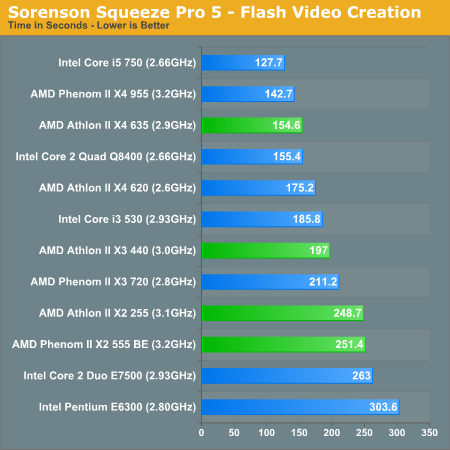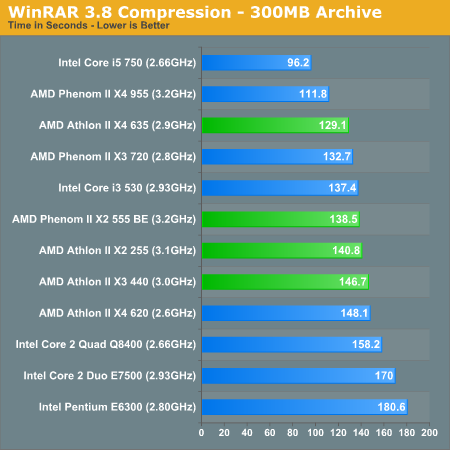AMD's New Year Refresh: Athlon II X4 635, Phenom II X2 555, Athlon II X2 255 & Athlon II X3 440
by Anand Lal Shimpi on January 25, 2010 12:00 AM EST- Posted in
- CPUs
PAR2 Multithreaded Archive Recovery Performance
Par2 is an application used for reconstructing downloaded archives. It can generate parity data from a given archive and later use it to recover the archive
Chuchusoft took the source code of par2cmdline 0.4 and parallelized it using Intel’s Threading Building Blocks 2.1. The result is a version of par2cmdline that can spawn multiple threads to repair par2 archives. For this test we took a 708MB archive, corrupted nearly 60MB of it, and used the multithreaded par2cmdline to recover it. The scores reported are the repair and recover time in seconds.

The Athlon II X3 and X4 do very well here thanks to the test being quite parallelized. The dual core options are competitive though.
Sorenson Squeeze: FLV Creation
We're using Sorenson Squeeze to convert regular videos into Flash videos for use on websites.

The trend continues given the threaded nature of this test. The dual-core AMD chips are more competitive than usual here, they are significantly faster than the Pentium E6300.
WinRAR - Archive Creation
Our WinRAR test simply takes 300MB of files and compresses them into a single RAR archive using the application's default settings. We're not doing anything exotic here, just looking at the impact of CPU performance on creating an archive:











63 Comments
View All Comments
Nfarce - Monday, January 25, 2010 - link
"A huge number of us own a Core2Duo E8xxx series CPU. Can you please post the benchmarks of one of them in this review to give us an idea of how it compares to an overclocked I3 530 or Phenom 2 555? Thanks."Actually you can take their data on the E7500 here and extrapolate the information from that vs. where an E8600 (or whatever) is in other similar tests and then plug it back in here.
At least, that's what I do. It doesn't take much time and usually there's a reason why AT will leave a certain chipset out (not sure why they chose the E7500 here over an E8500 however).
Taft12 - Wednesday, January 27, 2010 - link
not sure why they chose the E7500 here over an E8500 howeverBecause the E8000 series is in a different pricing universe compared to the CPUs discussed here. They should not under any circumstances be considered by any buyer in today's market.
But indeed you can use the E7500 as a good baseline. The clockspeed is nearly the same so the performance will be marginally better than the E7500 based on larger cache and faster FSB, but not by a whole lot.
Tamdrik - Monday, January 25, 2010 - link
Wow, is the newer X58 platform that much more energy efficient than the X48? I was shocked to see the Core i3 system at load consuming less power than the Pentium E6300 at idle, especially considering the latter is a 65W TDP part, which is less than the i3 at 73W. I think the GT280 by itself idles at around 50W, so the rest of an X58 system idles at under 40W (presumably including ~10W or so of PSU losses) vs. twice that for an X48? That's crazy.IntelUser2000 - Monday, January 25, 2010 - link
Anand seems to have completely forgot that X58 chipsets only run LGA1366 CPUs. The test page should show either a P55 or H55.The TDP of the Clarkdale's are with iGPU, so it'll fare better comparatively against Core 2 with discrete GPUs.
ET - Monday, January 25, 2010 - link
The Athlon II X2 255 beats the Phenom II X2 555 BE in Far Cry 2, and it's slower and has less cache. So what's its secret?BTW, it looks from these benchmarks that the slowest CPU works well for these games. I wonder if there's a larger difference in the minimum frame rate.
nubie - Monday, January 25, 2010 - link
Latency.The Phenom X2 is a cut-down X4 with level 3 cache.
The Athlon II X2 is a designed Dual-Core with no level 3 cache (and LARGER level 2 caches per core.)
Anandtech did a review on the Athlon II X2:
http://www.anandtech.com/cpuchipsets/showdoc.aspx?...">http://www.anandtech.com/cpuchipsets/showdoc.aspx?...
I for one had been waiting about 5 years for them to come out with this chip. And it is about time. The 65nm process never got 1MB level 2 Cache per core, we had to stick with 90nm and wait for these 45nm chips.
GeorgeH - Monday, January 25, 2010 - link
Actually, "ET" is right - something very weird is going on.Compare:
Athlon II X2 250 @ 3.0GHz - 36FPS
Athlon II X2 255 @ 3.1GHz - 45.8FPS
That's got to be the most magical 3% clockspeed bump in the history of the PC.
Taft12 - Wednesday, January 27, 2010 - link
I am not seeing what you are talking about. I see 45.8FPS for the X2 255, but there is no 36FPS except for the quad-core. I don't see Athlon II X2 250 on any of these graphs...Anyway, I agree with nubie that the Athlon II X2 is the real gem in AMD's current lineup with the jacked-up clockspeeds and huge L2 cache per core. These allow for fantastic systems at unbelievable prices!
GeorgeH - Wednesday, January 27, 2010 - link
The benchmarks were taken from Bench (Anandtech’s CPU benchmark repository). Just so what’s going on is a bit clearer:Phenom II X2 550 BE @ 3.1GHz – 41FPS
Phenom II X2 555 BE @ 3.2GHz – 43.6FPS
100MHz gets you 2.6FPS or 6%
Athlon II X4 630 @ 2.8GHz – 40FPS
Athlon II X4 635 @ 2.9GHz – 40.2FPS
100MHz gets you 0.2FPS or 0.5%
Athlon II X3 435 @ 2.9GHz – 40FPS
Athlon II X3 440 @ 3.0GHz – 42.8FPS
100MHz gets you 2.8FPS or 7%.
Athlon II X2 250 @ 3.0GHz – 36FPS
Athlon II X2 255 @ 3.1GHz – 45.8FPS
100MHz gets you 9.8FPS or 27%.
To quote Firefly’s Jubal Early – “Does that seem right to you?”
StormyParis - Monday, January 25, 2010 - link
I conclude that I still wouldn't use 4 cores for anything...